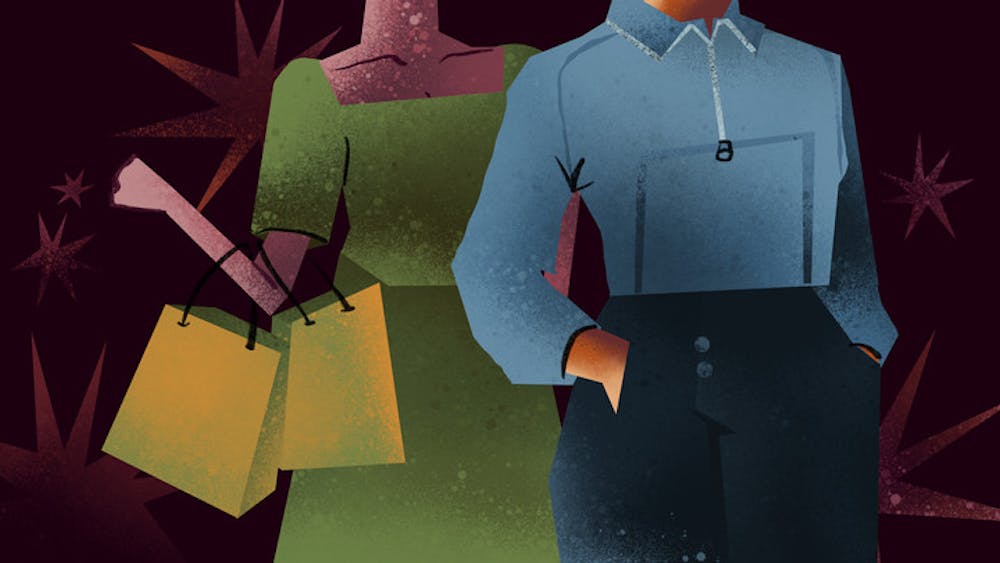Luxury is only getting more expensive. And for a long time, it defied the basic laws of ECON 0100: As prices rose, so did demand.
But even luxury has its limits. And lately, it seems we’re nearing them.
People aren’t buying into luxury’s attempts to make themselves even more exclusive anymore. Instead, they wear dupes—keeping the look, skipping the markup.
Buying dupes isn’t anything new, but owning them with pride is. Just a decade ago, being caught wearing a knockoff might’ve been a fashion faux pas, but today, it might even be a bragging right. What used to be seen as embarrassing is now a symbol of savviness. In a way, dupes have become a rebellion against fashion’s long–standing gatekeeping—proof that style can exist outside the confines of class and capital.
On TikTok alone, the #dupe hashtag has nearly six billion views and features creators proudly advertising cheaper alternatives to high–end, designer options. And, because of social media normalizing dupes, people are shamelessly wearing them. While not long ago, it might've been seen as “cheap” to wear a dupe, now, it’s a win that laughs at luxury shoppers’ bills. Frugality has become fashionable, even aspirational.
In pursuit of restoring exclusivity, luxury brands have increased average prices by 60% since 2019 without improving quality. And, when these brands already charge an inflated price—an average markup of eight to 12 times the production cost of their goods—for an ordinary product, they further alienate their entry–level customers.
This marks a significant shift from the previous strategy that luxury brands had been following. Over the last two decades, luxury companies were “democratizing” access, attracting middle–class consumers with more accessible price points through cosmetics, sunglasses, and mini–bags. Ultimately, by opening the doors to luxury with lower–priced products, the value of the industry’s global sales more than tripled.
But, with their expansion, luxury brands began to fear they’d lost their edge, drifting dangerously close to mainstream fashion. With social media OOTDs, “what’s–inside–my–closets,” and Pinterest boards, people can easily see and buy from trend–forward creators’ wardrobes, which makes these supposedly scarce products appear conventional. Luxury’s mystique used to be its distance—something you admired from afar. Now, it’s been flattened into content, turned into a carousel of links and affiliate codes.
Now, luxury brands are focusing on a smaller fraction of their clientele—the wealthiest 1%—by increasing their prices. In effect, they’ve aggressively excluded the aspirational customers and middle–class professionals.
In their efforts to maintain exclusivity, it seems luxury brands have misjudged the market’s response. In raising prices, they’ve lost 50 million consumers in the last year alone. Previous luxury customers find these new prices offensive, wondering just how far brands are pushing their consumers to spend. After all, when a Dior handbag costs only $58 to make but is sold for $2,800, it raises the question—how much is too much?
Consequently, consumers are increasingly turning to once–overlooked, mid–market brands like Gap, Banana Republic, Cos, and J.Crew for dupes to previously coveted items. Once dismissed by fashion–forward individuals, these brands are now becoming trendy in their own right. And, when brands are shifting from overt branding to “if you know, you know” identifiers—Balenciaga’s exaggerated silhouettes, Loewe's puffed leather, or literally anything from The Row—people cannot tell the difference between designer and department. Those with an eye for luxury may be able to identify the “real thing,” but the average shopper can’t and, frankly, doesn't care.
Millennials and Gen Z aren’t just buying dupes for their price; they’re motivated by curiosity. Many want to just see whether the dupe is as good as the premium product and then populate #dupe with their findings. That explains why roughly 44% of Millenial and 49% of Gen Z shoppers have intentionally purchased a dupe, with many reporting that, even if they could afford the real thing, dupes still offer a solid alternative.
Not even Lululemon is safe from the dupe economy. Once, the subtle yet unmistakable Lululemon logo on a pair of black leggings was enough to justify the $100 price tag. But now, with over 150 million views for the #LululemonDupe hashtag on TikTok, people are questioning the need to spend that much when there are affordable leggings available. While it’s unknown whether the dupes are made by the same manufacturers as the original Lululemon products, many customers have praised the dupes for being just as “buttery soft.” In a blind “feel” test of the Costco dupe and Lululemon original, my MKTG 1010 class even agreed that Costco did the $118 Scuba Hoodie better.
Thanks to dupe culture, it’s almost stylish to be frugal. Now, a “good find” isn’t necessarily designer. It’s a high–quality and budget–conscious item with real value. The cultural shift proposes that it might even be more trend–forward to SABS in Banana Republic instead of splurging on Burberry. The Goyard can wait—the Gap will do just fine.
This change in mindset is encouraging consumers to rethink what truly matters when it comes to fashion, focusing more on value, quality, and practicality over the prestige of luxury brands. While out–of–reach designer brands aren't going anywhere anytime soon, they are definitely becoming less of a must–have for many.
Maybe the luxury look is even being redefined—one that's stylish, affordable, and accessible to everyone.

